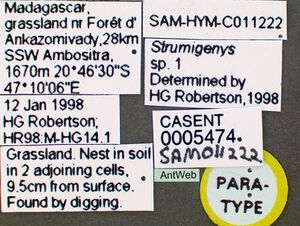Strumigenys adsita
| Strumigenys adsita | |
|---|---|

| |
| Scientific classification | |
| Kingdom: | Animalia |
| Phylum: | Arthropoda |
| Class: | Insecta |
| Order: | Hymenoptera |
| Family: | Formicidae |
| Subfamily: | Myrmicinae |
| Tribe: | Attini |
| Genus: | Strumigenys |
| Species: | S. adsita |
| Binomial name | |
| Strumigenys adsita Fisher, 2000 | |
A soil nesting species that has been found in rainforest and grasslands.
Identification
Bolton (2000) - The only member of the Strumigenys adsita-group. The enormously expanded keel on the petiole and the characteristic mandibular dentition make adsita one of the most easily recognized Malagasy species. These characters, coupled with the presence of spoon-shaped hairs on all dorsal surfaces and the hollow-triangular ventral spongiform lobe of the postpetiole, immediately isolate adsita from all other species.
Keys including this Species
Distribution
Latitudinal Distribution Pattern
Latitudinal Range: -20.76805556° to -20.775°.
| North Temperate |
North Subtropical |
Tropical | South Subtropical |
South Temperate |
- Source: AntMaps
Distribution based on Regional Taxon Lists
Malagasy Region: Madagascar (type locality).
Distribution based on AntMaps
Distribution based on AntWeb specimens
Check data from AntWeb
Countries Occupied
| Number of countries occupied by this species based on AntWiki Regional Taxon Lists. In general, fewer countries occupied indicates a narrower range, while more countries indicates a more widespread species. |

|
Estimated Abundance
| Relative abundance based on number of AntMaps records per species (this species within the purple bar). Fewer records (to the left) indicates a less abundant/encountered species while more records (to the right) indicates more abundant/encountered species. |

|
Biology
Castes
Worker
Images from AntWeb
   
| |
| Paratype of Strumigenys adsita. Worker. Specimen code casent0005474. Photographer April Nobile, uploaded by California Academy of Sciences. | Owned by CAS, San Francisco, CA, USA. |
   
| |
| Paratype of Strumigenys adsita. Worker. Specimen code casent0005473. Photographer April Nobile, uploaded by California Academy of Sciences. | Owned by CAS, San Francisco, CA, USA. |
    
| |
| Paratype of Strumigenys adsita. Worker. Specimen code casent0005472. Photographer April Nobile, uploaded by California Academy of Sciences. | Owned by MCZ, Cambridge, MA, USA. |
Nomenclature
The following information is derived from Barry Bolton's Online Catalogue of the Ants of the World.
- adsita. Strumigenys adsita Fisher, in Bolton, 2000: 624, figs. 381, 409 (w.q.) MADAGASCAR.
Unless otherwise noted the text for the remainder of this section is reported from the publication that includes the original description.
Description
Worker
Holotype. TL 2.1, HL 0.48, HW 0.44, CI 91, ML 0.14, MI 29, SL 0.25, SI 58, PW 0.28, AL 0.51. With the above characters and the following. Dorsal surfaces of head, alitrunk, waist segments and gaster blanketed with spatulate to spoon-shaped ground pilosity; similar hairs fringe upper scrobe margin and leading edge of scape. Apicoscrobal and pronotal humeral hairs absent. Standing hairs absent from first gastral tergite. Cephalic dorsum, dorsum and sides of alitrunk and petiole reticulate-punctate. Promesonotum slightly convex dorsally and posteriorly bluntly dorsolaterally marginate; propodeal dorsum sloping posteriorly to the declivity. Propodeum without differentiated teeth, the propodeal lamella continuous down declivity. Peduncle of petiole in profile with a broad translucent ventral keel; spongiform tissue limited to a narrow strip along ventral margin of keel. In profile, ventral spongiform lobe of postpetiole forms a hollow triangle. First gastral tergite with basigastral costulae oblique and radiating medially on each side of a central clear area. Margin of basal truncated area of first gastral sternite with row of short, scale-like hairs.
Paraypes. TL 1.9-2.1, HL 0.46-0.49, HW 0.41-0.44, CI 86-94, ML 0.14-0.16, MI 29-35, SL 0.24-0.27, SI 56-64, PW 0.27-0.28, AL 0.49-0.56 (11 measured). As holotype.
Type Material
Holotype worker, Madagascar: grassland near Foret Ankazomivady, 28 km. SSW Ambositra, 1670 m., 20°46'30"S, 47°10'6"E, 12.i.l998, grassland, nest in soil in 2 adjoining cells, 9.5 cm. from surface, found by digging, SAM #011222 (H. G. Robertson) (South African Museum).
Paratypes. 20 workers and 5 queens (4 alate and 1 dealate) with same data as holotype (The Natural History Museum, Museum of Comparative Zoology).
References
- Fisher, B.L. 2000. The Malagasy fauna of Strumigenys. Pp. 612-696 in: Bolton, B. 2000. The ant tribe Dacetini. Memoirs of the American Entomological Institute. 65:1-1028. (page 624, worker described)
References based on Global Ant Biodiversity Informatics
- Fisher B. L. 2003. Formicidae, ants. Pp. 811-819 in: Goodman, S. M.; Benstead, J. P. (eds.) 2003. The natural history of Madagascar. Chicago: University of Chicago Press, xxi + 1709 pp.
- Fisher, B.L. and H.G. Robertson. 2002. Comparison and Origin of Forest and Grassland Ant Assemblages in the High Plateau of Madagascar (Hymenoptera: Formicidae). Biotropica 34(1):155-167.

